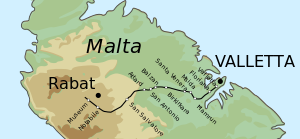Malta Railway
 |
|

Exit of a train from Valletta station
|
|
| Locale | Malta |
|---|---|
| Dates of operation | 1883–1931 |
| Track gauge | 1,000 mm (3 ft 3 3⁄8 in) metre gauge |
| Length | 7 mi (11 km) |
| Headquarters | Valletta |
| Malta Railway | |||||||||||||||||||||||||||||||||||||||||||||||||||||||||||||||||||||||||||||||||||||||||||||||||||||
|---|---|---|---|---|---|---|---|---|---|---|---|---|---|---|---|---|---|---|---|---|---|---|---|---|---|---|---|---|---|---|---|---|---|---|---|---|---|---|---|---|---|---|---|---|---|---|---|---|---|---|---|---|---|---|---|---|---|---|---|---|---|---|---|---|---|---|---|---|---|---|---|---|---|---|---|---|---|---|---|---|---|---|---|---|---|---|---|---|---|---|---|---|---|---|---|---|---|---|---|---|---|
|
|||||||||||||||||||||||||||||||||||||||||||||||||||||||||||||||||||||||||||||||||||||||||||||||||||||
The Malta Railway was the only railway line ever on the island of Malta, and it consisted of a single railway line from Valletta to Mdina. It was a single-track line in metre gauge, operating from 1883 to 1931. The railway was known locally in Maltese as il-vapur tal-art (the land ship).
The first proposal to build a railway in Malta was made in 1870 by J. S. Tucker. The main reason was to connect the capital Valletta with the former capital Mdina so the journey time between the two cities would be reduced from 3 hours to less than half an hour. A narrow-gauge railway system designed by John Barraclough Fell was initially proposed. In 1879, this was dropped in favour of a design by the engineering firm of Wells-Owen & Elwes, London. In 1880, the newspaper The Malta Standard reported that "in a short space of time, the inhabitants of these Islands may be able to boast of possessing a railway", and that the line was to be open by the end of 1881.
There were some problems with the acquisition of land to build the railway, so construction took longer than expected. The line was opened on 28 February 1883 at 3pm, when the first train left Valletta and arrived at Mdina after about 25 minutes.
Finances of the railway always proved critical. On 1 April 1890 the first proprietor, the Malta Railway Company Ltd., went bankrupt and the railway stopped running. As a result of this the government took over the railway, invested in its infrastructure and reopened traffic on 25 January 1892. From 1895 on an extension of the line was under work aiming for the barracks at Mtarfa behind the historic city of Mdina. This extension was opened for traffic in 1900.
In 1903 a company was founded which ran tramways on Malta from 1905 on, partly parallel to the railway line, and this competition had a negative effect on the railway's finances. The first buses were introduced in 1905 and became popular in the 1920s. This contributed to the decline of both the railway as well as the tramway. The tram company closed in 1929, while the railway line stopped operating on 31 March 1931.
...
Wikipedia
